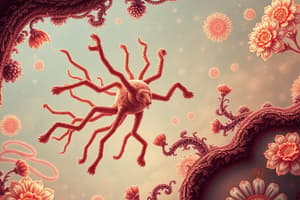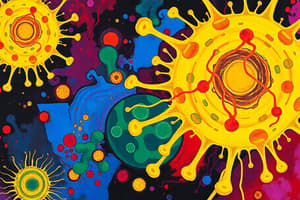Podcast
Questions and Answers
What is the primary mechanism of host damage by pathogens?
What is the primary mechanism of host damage by pathogens?
- Direct physical damage to host cells by the pathogen
- Bacterial growth in tissues and production of toxins (correct)
- Induction of host cells to produce nutrients for the pathogen
- Activation of the host's immune system to attack healthy cells
Which type of toxin is typically active in very low amounts and can cause severe effects?
Which type of toxin is typically active in very low amounts and can cause severe effects?
- Endotoxins
- Lipopolysaccharides
- Exotoxins (correct)
- Proteases
What is the term used to describe the capacity of organisms to produce toxins?
What is the term used to describe the capacity of organisms to produce toxins?
- Toxicity potential
- Toxinogenesis
- Toxigenicity (correct)
- Toxin proliferation
Where are endotoxins located in bacterial cells?
Where are endotoxins located in bacterial cells?
Which type of toxin can be heat-inactivated but still provoke the production of antitoxins?
Which type of toxin can be heat-inactivated but still provoke the production of antitoxins?
Which toxin affects neuromuscular junctions and blocks release of inhibitory neurotransmitters, causing irreversible muscle contraction and spastic paralysis?
Which toxin affects neuromuscular junctions and blocks release of inhibitory neurotransmitters, causing irreversible muscle contraction and spastic paralysis?
Which microbe causes botulism by affecting neuromuscular junctions and preventing the release of excitatory neurotransmitter in peripheral nerves?
Which microbe causes botulism by affecting neuromuscular junctions and preventing the release of excitatory neurotransmitter in peripheral nerves?
Which type of toxin can damage membranes by enzymatic action, such as phospholipase activity?
Which type of toxin can damage membranes by enzymatic action, such as phospholipase activity?
Which component of the outer membrane of gram-negative bacteria is the toxic component that promotes inflammation and fever?
Which component of the outer membrane of gram-negative bacteria is the toxic component that promotes inflammation and fever?
"Formation of inclusion bodies" is an example of which cytopathic effect caused by viruses?
"Formation of inclusion bodies" is an example of which cytopathic effect caused by viruses?
Which type of toxin provokes an intense immune response and causes fever, nausea, vomiting, diarrhea, and shock?
Which type of toxin provokes an intense immune response and causes fever, nausea, vomiting, diarrhea, and shock?
What is the primary mechanism through which HIV causes damage to the immune system?
What is the primary mechanism through which HIV causes damage to the immune system?
Which microbe causes disease through various means including respiratory tract, gastrointestinal tract, genitourinary tract, skin, and blood?
Which microbe causes disease through various means including respiratory tract, gastrointestinal tract, genitourinary tract, skin, and blood?
What is the term used to describe inactive exotoxins that can be used as vaccines?
What is the term used to describe inactive exotoxins that can be used as vaccines?
Which type of toxin targets various types of host cells including nerve cells (neurotoxins), cells lining the gut (enterotoxins), and heart cells (cardiotoxins)?
Which type of toxin targets various types of host cells including nerve cells (neurotoxins), cells lining the gut (enterotoxins), and heart cells (cardiotoxins)?
Flashcards are hidden until you start studying
Study Notes
- Botulism and staphylococcal food poisoning are caused by exotoxins produced by bacteria.
- Body responds to exotoxins by producing antitoxins in the form of antibodies.
- Exotoxins can be heat-inactivated but still provoke the production of antitoxins.
- Inactive exotoxins are called toxoids and can be used as vaccines, such as diphtheria and tetanus vaccines.
- Exotoxins can target various types of host cells, including nerve cells (neurotoxins), cells lining the gut (enterotoxins), and heart cells (cardiotoxins).
- Diphtheria and tetanus are examples of diseases caused by neurotoxins. Diphtheria toxin inhibits protein synthesis in heart muscle and other cells. Tetanus toxin affects neuromuscular junctions and blocks release of inhibitory neurotransmitters, causing irreversible contraction of muscle and spastic paralysis.
- Botulism is caused by Clostridium botulinum and affects neuromuscular junctions, preventing release of excitatory neurotransmitter in peripheral nerves.
- Membrane-disrupting toxins can damage membranes by enzymatic action, such as phospholipase activity of C. perfringens a-toxin.
- Superantigens provoke an intense immune response and cause fever, nausea, vomiting, diarrhea, and shock. Examples include Staphylococcus aureus enterotoxin and toxic shock syndrome toxin (TSST-1).
- Endotoxins are a component of the outer membrane of gram-negative bacteria, composed of lipid A, lipid portion of LPS, and an O-specific polysaccharide side chain. Lipid A is the toxic component that promotes inflammation and fever.
- Endotoxins can cause endotoxic shock by stimulating macrophages to release cytokines, leading to chills, fever, weakness, muscle ache, shock, and potential fatality.
- Viruses are also capable of causing disease through various mechanisms, including attachment sites on host cells and evasion of host defenses. HIV specifically binds to CD4 positive cells, mainly T cells, and actively attacks immune system components.
- Cytopathic effects of viruses include cell lysis, formation of inclusion bodies, syncitium formation, and determination of cytopathic effect in laboratory cell lines for diagnosis.
- Microbes cause disease through various means, including respiratory tract, gastrointestinal tract, genitourinary tract, skin, and blood, using portals of exit such as coughing, sneezing, feces, and urine.
Studying That Suits You
Use AI to generate personalized quizzes and flashcards to suit your learning preferences.




